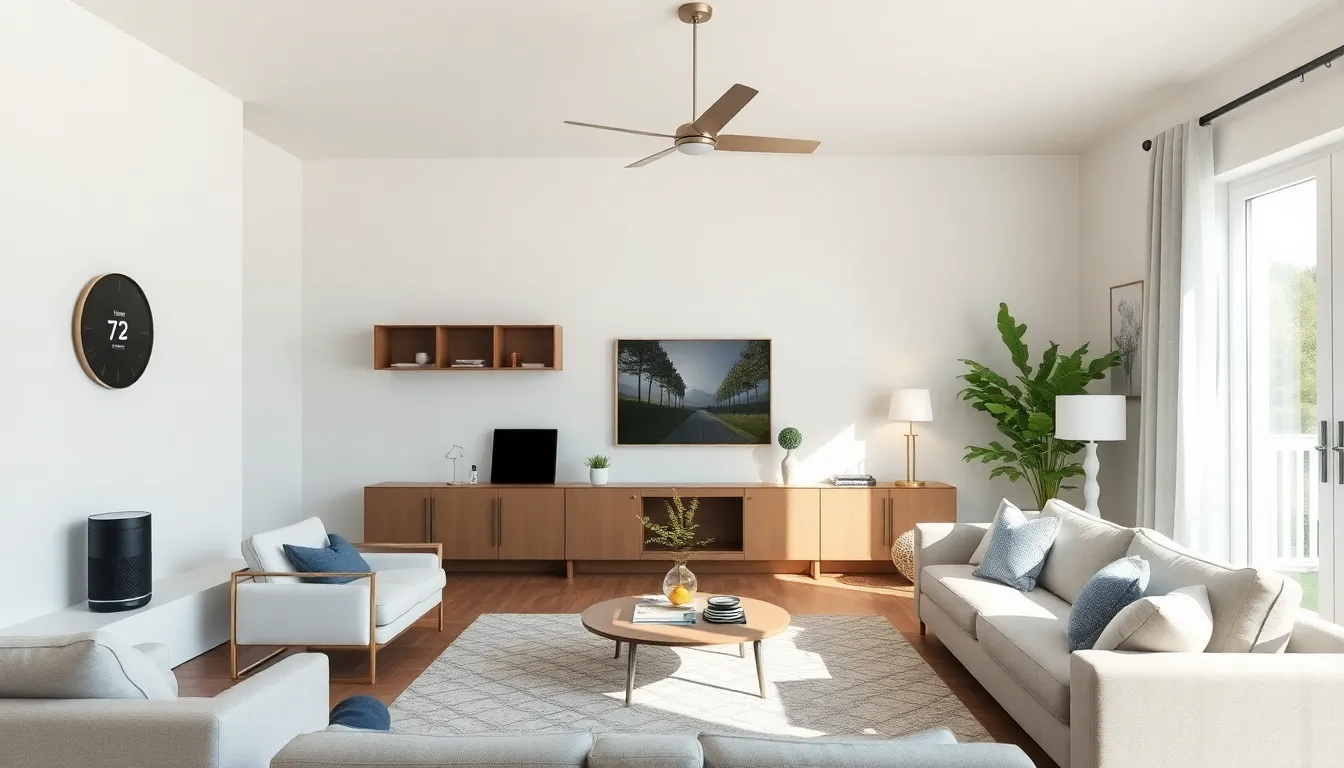Imagine waking up to the gentle hum of your coffee maker brewing your favorite blend, while the lights gradually brighten to mimic a sunrise. Sounds like a scene from a sci-fi movie, right? Welcome to the world of home automation devices, where technology transforms everyday living into a seamless experience.
Table of Contents
ToggleOverview of Home Automation Devices
Home automation devices streamline household tasks, enhancing convenience and efficiency. These devices include smart speakers like Amazon Echo and Google Nest, which allow voice control over various functions. Lighting systems such as Philips Hue adjust brightness and color based on time or preferences.
Security is another crucial aspect, with products like smart locks and cameras providing peace of mind. Smart thermostats, such as Nest and Ecobee, optimize heating and cooling, contributing to energy savings. Additionally, smart appliances like refrigerators and washing machines enhance daily chores by offering remote operation and monitoring capabilities.
Connectivity among devices is vital, facilitated by protocols like Wi-Fi, Zigbee, and Z-Wave. Enhanced integration leads to more comprehensive automation. For instance, a morning routine could involve programmed sequences where the thermostat adjusts, lights brighten, and coffee brews simultaneously.
Smart hubs serve as central controllers, allowing users to manage multiple devices from one interface. Through phone apps or voice commands, individuals gain effortless control over their home environments. Data collection enables users to track energy usage patterns, further informing efficiency strategies.
Scheduling and automation rules create customized experiences tailored to preferences. For families, setting routines not only simplifies tasks but also provides comfort and security. Overall, the variety of home automation devices available empowers users to create a personalized and connected living space.
Benefits of Home Automation Devices

Home automation devices offer a range of benefits that significantly enhance daily living. These benefits include increased convenience, enhanced security, and energy efficiency.
Increased Convenience
Convenience defines modern living. Smart speakers control various devices with simple voice commands, allowing users to adjust lighting or play music effortlessly. With smart appliances, managing laundry and cooking from a phone becomes standard. Scheduling tasks through apps simplifies daily routines. Automation ensures that lights turn on and off according to personal preferences. Customizing home environments promotes relaxation and comfort. Regular updates and integrations keep devices functioning at their best.
Enhanced Security
Security improves with the integration of smart devices. Smart locks provide keyless entry, offering flexibility and safety. Cameras monitor properties in real time, sending alerts if unusual activity occurs. With motion sensors, homeowners can receive notifications instantly. Remote access to surveillance feeds enhances peace of mind during travels. Integrating home alarms with automation systems creates a robust safety network. Overall, these features make homes safer while empowering homeowners to respond to potential threats effectively.
Energy Efficiency
Energy efficiency becomes a significant consideration with smart technology. Smart thermostats optimize heating and cooling schedules, reducing energy waste. Users can monitor energy consumption through dedicated apps, gaining insights on usage patterns. Automated lighting adjusts based on occupancy, preventing unnecessary power usage. Smart plugs enable remote control of non-connected devices, ensuring they’re shut off when not in use. These energy-saving techniques translate to lower utility bills, benefitting both the environment and personal finances.
Types of Home Automation Devices
Home automation devices come in various forms, each designed to enhance convenience and efficiency in everyday living. The most common categories include smart lighting, smart thermostats, security cameras and alarms, and smart speakers and assistants.
Smart Lighting
Smart lighting systems allow users to control their home’s ambiance effortlessly. Philips Hue and LIFX provide adjustable brightness and a spectrum of colors, ensuring tailored lighting for any occasion. Automating lighting creates energy savings by scheduling lights to turn off when not needed. Motion sensors can activate lights automatically in hallways or entryways, enhancing safety. Integration with smart hubs enables voice commands for a hands-free approach. User-friendly apps provide control over multiple fixtures, fostering convenience at the user’s fingertips.
Smart Thermostats
Smart thermostats optimize home heating and cooling for maximum energy efficiency. Nest and Ecobee learn user habits, adjusting temperatures based on occupancy patterns. Scheduling settings enhance comfort by programming when to heat or cool specific rooms. Remote access allows users to monitor and adjust settings via smartphone apps, saving energy during away periods. These devices also provide insights into energy usage, helping users make informed decisions to reduce utility bills.
Security Cameras and Alarms
Security cameras and alarms offer peace of mind for homeowners. Brands like Ring and Arlo provide high-definition video monitoring with options for motion detection alerts. Users can access live feeds from smartphones, ensuring awareness of activity outside their homes. Integration with smart locks and sensors enhances overall security, offering comprehensive protection. Notifications about unusual movements keep families informed in real-time. Many systems allow remote control of alarms, providing another layer of safety and convenience.
Smart Speakers and Assistants
Smart speakers and assistants facilitate hands-free control of various devices within the home. Amazon Echo and Google Nest integrate seamlessly with compatible devices, serving as central control points. Voice commands simplify operations, such as adjusting lighting, setting thermostats, or playing music. These devices offer information updates, reminders, and entertainment, enhancing daily productivity. Users benefit from personalized routines, ensuring that automation aligns with individual preferences and needs.
Considerations When Choosing Home Automation Devices
Selecting home automation devices requires careful consideration of several factors to ensure a seamless experience.
Compatibility and Integration
Look for devices that work well with existing systems. Many automation solutions support Wi-Fi, Zigbee, or Z-Wave protocols for smooth connectivity. Smart hubs often enhance integration, enabling multiple devices to communicate efficiently. Consider whether the devices connect easily with other brands, as interoperability increases functionality. Prioritize those that allow for future expansions or updates as newer technologies emerge.
User-Friendliness
Ease of use is essential when selecting home automation devices. A user-friendly interface promotes interaction without frustration. Intuitive apps and voice control functionality simplify operation for all family members. Review customer feedback regarding installation and daily usage experiences. Devices that offer clear instructions and responsive customer support help resolve any issues that may arise. Consider options that allow customization based on individual needs and preferences for convenience.
Cost and Budget
Determine your budget before purchasing home automation devices to avoid overspending. Prices vary significantly among brands and features. Some devices may offer significant long-term savings, such as smart thermostats that reduce energy bills. Compare the upfront costs with potential savings over time to find the best fit. Research available discounts, bundles, or financing options to optimize overall expenditures. Always align device selections with personal financial goals for responsible spending.
Home automation devices are transforming how people interact with their living spaces. By integrating technology into everyday routines, they enhance convenience and security while promoting energy efficiency. The variety of available devices allows users to tailor their environments to fit personal lifestyles seamlessly.
As technology continues to evolve, these devices will only become more sophisticated and accessible. Embracing home automation can lead to a more comfortable and efficient home life. With careful consideration of compatibility and user-friendliness, anyone can create a connected space that meets their needs and preferences. Investing in these innovations not only simplifies daily tasks but also enhances overall quality of life.


